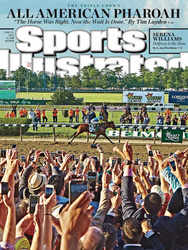
The Case for ... Playing College Ball
THIS MONTH, THE NBA draft will feature a rare prep-to-pro player: point guard Emmanuel Mudiay, the Texas high school phenom who passed on a scholarship offer from SMU to play in China last season. Mudiay and Brandon Jennings are the most high profile players to decide against a one-year pit stop in college in favor of a lucrative contract overseas.
In 2008, when Jennings signed with Lottomatica Roma in Italy, Sonny Vaccaro, the influential former sneaker-company power broker, predicted a revolution. Dozens of high school stars would spend their NBA-mandated post-high-school year in Europe or Asia, collecting checks instead of taking exams. Now Orangeville (Ont.) Prep star Thon Maker, a 7-foot forward, is reportedly considering following Mudiay's lead. That may look like a trend, but there will be no mass exodus.
Going overseas has its obvious appeals. There's money; Jennings and Mudiay each pocketed $1.2 million for their seasons abroad, plus cash earned through apparel contracts. Playing against grown men helps developmentally, too. Mudiay practiced against Yi Jianlian, 27, a five-year NBA veteran, and played against Stephon Marbury, 38, a two-time NBA All-Star. In China, Mudiay packed on 10 pounds and played "the most physical style I've ever played."
Still, most teens elect to stay Stateside. They dream of winning a national championship—ratings for the 2015 NCAA tournament were the highest in 22 years—and blue-chip prospects gravitate toward Kentucky, Duke and other one-and-done factories, where the experience is undoubtedly more comfortable than a year in a foreign land. In China, Mudiay battled language and cultural barriers. The presence of family members helped, but days off consisted of watching sports documentaries and a night out was usually an extra trip to the gym. A dose of dorm life and cafeteria food never sounded more appealing.
College coaches look at players as an investment and commit time to developing them. Many players are not ready to go pro after one year. They get injured or, more likely, they are not as good as they thought they were. But overseas, such players are replaceable. After Mudiay suffered an ankle injury early in the season, he was quickly swapped for NBA vet Will Bynum.
There are advantages to playing where it's easier for NBA executives to watch, too. Every team employs international scouts, but when a GM can hop a quick flight to a game—and can receive trusted feedback from a coach he has a relationship with—he becomes more comfortable drafting a player. "It's not a perfect system," says an NBA GM. "But to me, you can project a player's career arc more accurately after a year at a major college than one overseas."
Looking ahead, there is an unaccounted variable. The NBA plans to push hard for an age minimum of 20 when the league and players can opt out of the current collective bargaining agreement in 2017. Michele Roberts, the executive director of the NBA Players Association has pushed back ("It's not going to be two-and-done," Roberts said in February), but will pro players be willing to go to the wall for an issue that doesn't directly affect them? Top prospects are willing to play for free for one year; will they be as willing to play for two?
Unless the D-League can find a way to increase its max salary (currently in the mid-$20,000s) to something in the low six figures, college will always be the preferred path for American teenagers with NBA dreams. Fear of academic ineligibility pushed Jennings to Italy; similar concerns pivoted Mudiay away from SMU. Money matters, but seven years after Jennings left, it's clear high school stars aren't willing to go abroad to get it.
Orangeville Prep star Thon Maker, a 7-foot center, is reportedly considering following Mudiay's lead and playing overseas.
PHOTO
GREGORY PAYAN/AP

